Folding phones offer all of the features of a flagship device, like an Apple’s iPhone 15, and then some. With two displays—one on the outside of the handset and another, larger screen that can be used when the two halves of the phone smartphone are opened like a book, foldables represent the top of the mobile device food chain. And, they’ve got a price to match. When you’re considering buying a piece of hardware worth the equivalent of one month’s rent in some cities, you want to make sure that you carefully weigh your options before pulling the trigger on that purchase.
We pitted two of the most popular folding phones in the world against each other: the OnePlus Open and Google’s Pixel Fold. After spending a few weeks using both, we recommend the OnePlus Open. It’s a fast, thoughtfully designed device with two big, beautiful displays, a great camera system, outstanding battery life, and close to half a decade of upcoming software support. For those looking for a smartphone to help them stay productive on the go, this is the folding phone you want.
This isn’t to say that the Google Pixel Fold isn’t a great device either. As you’ll see below, it has a lot going for it. If you can find it on sale, it’s worth your consideration.
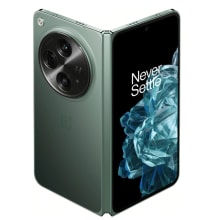
OnePlus Open
With nods to its versatility, compact build and decent battery life, the OnePlus Open is a smartphone whose performance won’t disappoint.
![]()
Google Pixel Fold
The Google Pixel Fold has a sleek aesthetic and a stunning ultrawide camera, making it an ideal companion for your day to day.
OnePlus Open vs. Google Pixel Fold: Design
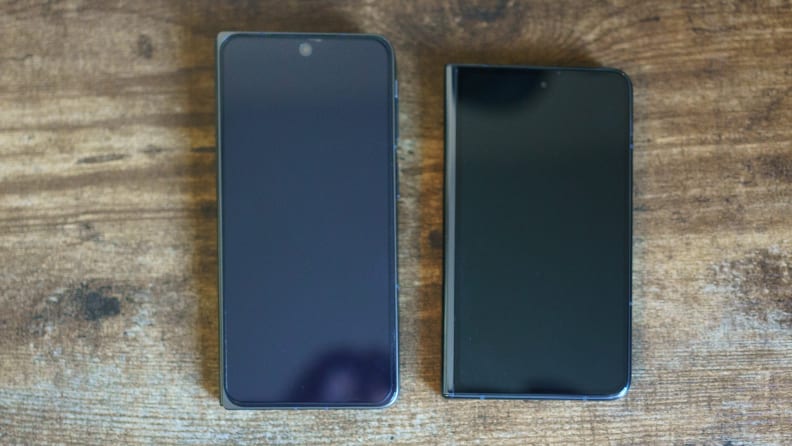
Credit: Reviewed / Séamus Bellamy
When placed side-by-side, it’s easy to see the difference in dimensions between these two folding phones.
We always wind up paying through the nose for new technology. While foldable smartphone displays have been around for a few years, the hardware baked into them still sells for a significant premium versus similarly equipped handsets that ship with a single, non-foldable display. When you pay a premium price for a smartphone, you should expect it to have a premium design. The OnePlus Open and Google Fold both tick off that box.
The OnePlus Open we tested features dark grey aluminum accents along its bezels and hinge. Its large, round camera bump and textured faux leather back are reminiscent of a classic film camera. It’s also available in an attractive Jade colorway. What’s more the texture of the phone’s backplate and the orientation of the camera bump make it easier to hold while using it as a camera, or while using its interior, folding display.
That said, there’s no way to lay the Open flat on its back, on a tabletop. You don’t want to lay it face down on its exterior display when not in use: on more than one occasion during testing, the handset slipped right off the surface I’d set it on and fell to the (thankfully) carpeted floor. I deeply appreciate one of OnePlus’ hallmark features, which all of its flagship devices ship with an option slider button on the side of the handset. It’s designed to quickly let you switch between having the phone’s ringer on blast, vibrating when a call or message comes in, or being completely silent. It’s a small convenience that I quickly grew to rely on as I moved between social and work occasions.
The Google Pixel Fold is just as handsome a handset as the OnePlus Open. But Google’s engineers decided on a more modern aesthetic than the one you’ll get from OnePlus. The Pixel Fold’s bezels are made of high-gloss aluminum. The finish looks incredibly premium and comes in two colors, Porcelain and Obsidian. I did note that the handset’s shiny metal bits tend to hold on to fingerprints (although they are quickly brushed away with the wipe of a cloth or shirt sleeve). The Pixel Fold’s camera array is iconic: a raised, rectangular bump that spans the back of the handset. It’s smaller than the one the OnePlus Open features and allows the handset to sit more stable on a flat surface.
After using the Pixel Fold for several weeks, I can’t say it was designed with how users intended to hold it in mind. The back panel of the Pixel Fold is made using smooth glass. Its bezels are slick. The glass of its main display and folding display are smooth as well. I always felt I needed to be mindful of how I held the Pixel Fold. It was hard to relax with it in hand, as I read or chatted with friends. That it weighs significantly more than the OnePlus Open—10 ounces versus 8.8 ounces—drives the relative discomfort of holding the Pixel Fold home.
Our pick: OnePlus Open
OnePlus Open vs. Google Pixel Fold: Display
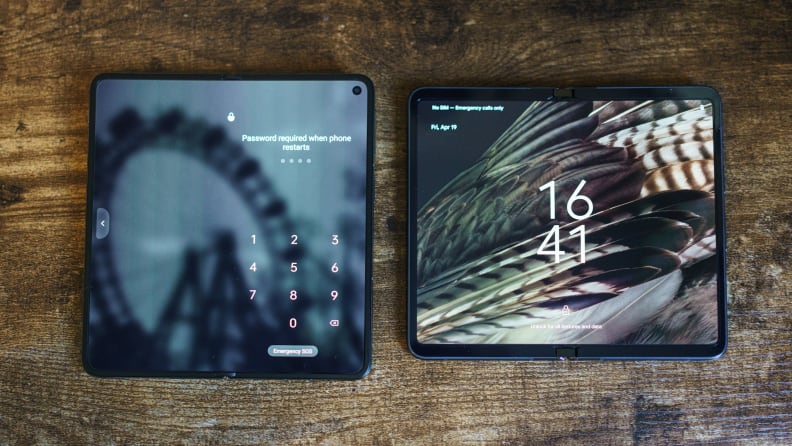
Credit: Reviewed / Séamus Bellamy
Both of these touchscreen phones have the versatility of a scaled-down tablet, taking multitasking productivity on the go to the next level.
There are only a couple of good reasons to throw your money at a folding phone. The first is size. Foldable devices like the Motorola Razr+ or Samsung Galaxy Z Flip5 bend in the middle of their single display to reduce their overall footprint. It makes the handset a lot easier to stash in the pocket of your jeans or a small purse. The second reason—and this one applies to the Google Pixel Fold and OnePlus Open—is multitasking. For those who need to be productive on the go, a device that can be used like a traditional smartphone most of the time, and then, when they need to look at a PDF during a Zoom call, they can open their handset up like a book and run two apps at once, side-by-side, to make staying productive on-the-go a whole lot easier. Superior mobile productivity without having to carry a tablet AND a phone? Sign us up.
The Google Pixel Fold, much like me, is a stout little fella. Its main display measures 5.8 inches in size, which puts it on the small side when compared to other flagship-level devices. As an individual with what I’d consider to be medium-sized hands, I appreciated the fact that I could more easily tap and swipe at the Pixel Fold’s FHD+ 1080p OLED display. Deep blacks and rich colors abound when using apps or watching streaming content. The device’s interior 7.6-inch folding 1080p OLED display looks almost as good. Both displays feature a 120 Hz refresh rate, making for fluid movement of whatever you’re looking at. However, the folding display’s resolution at 380ppi is slightly less than the main display’s 408ppi resolution. Most people won’t notice any difference while using the Pixel Fold, but it’s there.
The OnePlus Open’s main display is taller than the one its Google-made competition comes rocking: 6.31 inches. While the phone felt too tall for me to reach as much on-screen content with one hand, its size was better suited for watching wide-screen content. Dune (an epic designed for viewing on the small screen) looked better, to my eyes on the OnePlus Open than it did on the Pixel Fold. The colors on the Open’s OLED main display seemed more vibrant and there were no black bars at the top and bottom of the display. Open the, uh, Open up and you’ll be facing a 7.82-inch display with a nearly 1:1 aspect ratio (almost square.) It’s got a PPI of 426, which is higher than what the Pixel Fold’s folding display offers.
Our pick: OnePlus Open
OnePlus Open vs. Google Pixel Fold: Hinge
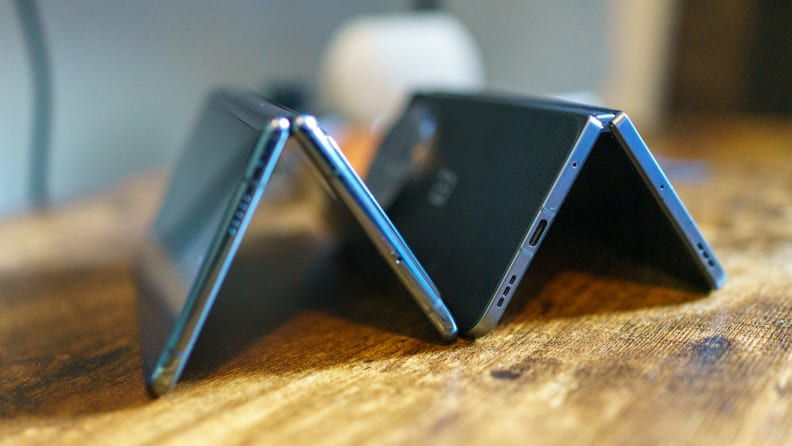
Credit: Reviewed / Séamus Bellamy
While the OnePlus Open’s high resolution display adapted smoothly from folded to unfolded, the Google Pixel Fold fell flat.
It’s fair to say that much of how happy you’ll be with your folding phone hinges on the quality of its hinge. Right now, every device with a foldable display out there comes packing a hinge and display that are rated to survive hundreds of thousands of openings and closings before they wear out. Hurray for durability! But beyond this, there are other things to consider when you’re talking about a handset’s bendy bits.
With your device’s internal display tucked away, there should be as small a gap between the two halves of its foldable glass display as possible. This is important, as debris, say a grain of sand that found its way into your pocket, could get between the two halves of the phone and scratch the screen’s protective outer coating. Worse still, should anything get into the gears and electronics contained within the hinge itself, your device could cease to function as it was designed to very quickly. Happily, we found that the hinge design of the OnePlus Open and the Google Pixel Fold provided similar levels of protection against debris getting into them. When closed, both handsets had minimal gaps where crud could get in.
How the hinge affects the appearance of the internal display when a folding phone is open is just as important. No one wants to use a device with a janky-looking display. If you’re paying for a high-resolution OLED device, it should provide the clearest image possible, so that you can enjoy the content you love and get work done without distraction or eyestrain. A divot in the middle of your folding phone’s flexible glass display? That’s a distraction.
We were disappointed to find that the Pixel Fold’s display crease was prominent enough to be noticeable while viewing many different types of content. The issue stems from the fact that the handset doesn’t open up completely flat. You’ll also notice it as you tap and swipe your day away. The hinge divot on the OnePlus Open’s internal display seemed, to our eyes, much less noticeable than the Pixel Fold’s. The phone opens up flatter and, as a result, its internal display provides a better user experience than the Pixel Fold can manage.
Our pick: OnePlus Open
OnePlus Open vs. Google Pixel Fold: Battery Life And Charging

Credit: Reviewed / Séamus Bellamy
The designs of the One Plus Open and Google Pixel fold are iconic. Which one you think looks better is a matter of personal preference.
The battery life of any smartphone is one of the most important factors when considering whether owning one will be a win or a frustrating plug-it-in-three-times a day dud. This is especially true for power users who are on their device constantly as they do their job, and for gamers who run processor-heavy apps that eat through a handset’s power reserves faster than a rottweiler can down a pork chop.
We tested the Google Pixel Fold as our daily driver for a couple of weeks for work and, in the evenings, streaming videos from a Plex Server and playing a bit of Civilization VI on its folding display. On average, we were able to squeeze around five and a half hours of total screen time out of its 4821 mAh battery. Performing the same tests with the OnePlus Open, which comes packing a 4805 mAh battery, we found that it provided between five and six hours of battery life before needing to be recharged. And, when relegated to less demanding duties—answering the occasional email, text and browsing the news—we found that both handsets were capable of plugging away from the time I woke up until morning, the following day, before needing to be topped off.
Given that no two workdays are the same, and the tasks we performed with these devices varied, we feel it’s safe to call this one a draw.
Our pick: Tie
OnePlus Open vs. Google Pixel: Fold User Experience
Much like a phone’s design, how much the user experience of a given smartphone makes its owner happy is highly subjective. A feature like the Google Pixel Magic Editor might make casual photographers happy: it provides an easy way to create great photo compositions, after the fact. A more seasoned smartphone photographer might hate this feature, as it makes creating a great shot less challenging. The difficulty of capturing a great image is half the fun of taking pictures.
The Google Pixel Fold and the OnePlus Open both come packing this feature. They both have excellent, high-resolution camera arrays baked into them that perform well in most lighting conditions. Both handsets come with 48-megapixel ultrawide main cameras, along with additional, powerful lenses for telephoto and portrait photography. Their front-facing cameras will up your selfie game and are great for video calls. That said, there’s no denying that the Pixel Fold takes better photos than the OnePlus handset can manage. Google is better at creating camera software that can make the best of the tiny sensors in a smartphone handset array than OnePlus is. The OnePlus Fold’s camera system is still very good and should make most people happy.
They’re both pretty well-matched when it comes to speed, as well. Without getting into the geeky specifics of benchmarks, we can tell you that these smartphones, during the weeks we tested them, were both consistently fast at any task we threw at them, and offered butter-smooth animations and scrolling for any content we perused, created, or played. This is thanks to the proprietary tensor g2 chip in the Pixel Fold and the OnePlus Open’s zippy Snapdragon Gen 8 processor. And, of course, being Android devices, they both come with access to all of Google’s apps and services, along with the thousands of apps available to download from the Google Play Store.
The big difference between the user experience of the OnePlus and Google hardware is in how the two companies have skinned their versions of Android.
In the case of The Google Pixel Fold, more tinkering needs to be done. Except for a few tweaks to optimize the device for split-screen multitasking, you’ll find it runs as close to a ‘stock Android’ experience as possible. This is Google’s vision of Android 13, as it was meant to be. We enjoy using stock Android because of its simplicity, and lack of flashy, unnecessary bloat. After setting up the phone for the first time, you’ll find that Google’s most popular apps come pre-installed. But nothing else. This makes it easier to get up and running with your new phone, as you’re not doing the busy work of deleting unwanted flotsam.
However, we were both disappointed and perplexed by how little Google’s Material Design aesthetic limited where we could place widget items on the home screens. Even when there was room for them, banal but important widgets like a clock or the weather could only be placed in certain spaces on our display during testing—something we have not run into, in the past, with Android and its breezy approach to customization.
At the time we tested these handsets, the OnePlus Fold used a customized version of Android 13 called Oxygen OS: a skinned iteration of the Android operating system owned by OnePlus’ parent company, Oppo. Using Oxygen OS feels very similar to stock Android, but its design elements and tweaks to how users interact with its various functions make it unique enough to note. It comes with additional features such as Zen Space, to help you focus on tasks or block the world out, a proprietary phone cloning app to make switching to your new handset from an existing iPhone or Android phone a cinch, and elements such as the ability to extract text from screenshots and being able to easily move files between multiple OnePlus devices makes it an attractive option. All of these features, however, could be considered bloat, by some users. What’s more, we found that the OnePlus Open offered more varied windowing options for multitasking on its internal display, making it all the more useful to pros on the go.
Which OS experience you prefer is a personal matter. We prefer Oxygen OS over what Google Pixel devices offer. But as users of OnePlus devices, in our downtime, for many years, our fondness for Oxygen OS may stem from familiarity. So, your mileage may vary.
Our pick: Tie
OnePlus Open vs. Google Pixel: Support
At the time that this feature was written folding phones were frigging pricey. You can buy one or, in many cities, pay a month’s rent on a nice one-bedroom apartment. An investment like this should last you a good, long time. A significant part of what ensures a smartphone’s longevity is how long its manufacturer is willing to support it with software updates. These updates are vital for stomping out bugs and ensuring your digital security, not to mention introducing features that can make an aging handset feel fresh.
Currently, the clear winner in this category is the Google Pixel Fold. Google promises that their foldable will receive at least five years of software, security, and more than a few new features. By contrast, OnePlus will only be providing four years of Android OS updates and five years of security updates. “There are security updates, so what’s the big deal,” you ask. Well, many apps, as they’re updated, will no longer work with older versions of the operating system they were designed for. They rely on the features of the latest version of the OS to run. So, while your device may be secure, that new game you want to run could, potentially, be a no-go.
Our pick: Google Pixel Fold
And the Winner is… the OnePlus Open
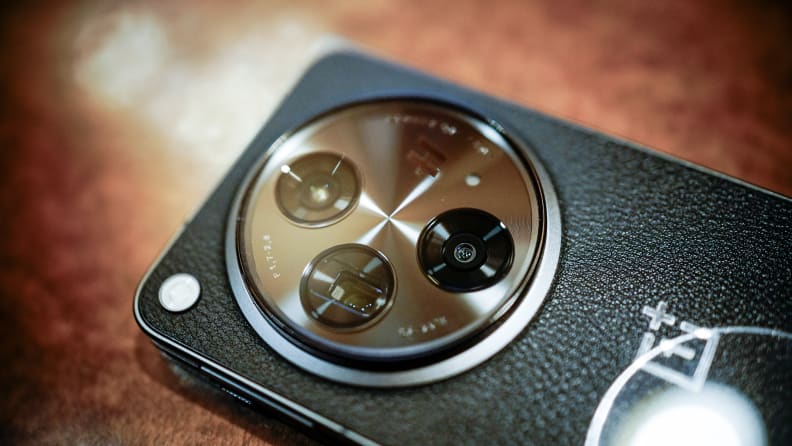
Credit: Reviewed / Séamus Bellamy
The OnePlus Open’s camera array can capture some impressive photos. However, it can’t match the Google Pixel Fold’s excellent photo software’s capabilities.
The Google Pixel Fold is a great folding phone that could make you happy for years. If you can land one as part of a contract with your cellular carrier or see it on sale at a discount, don’t hesitate to pick one up. With its speed, great battery life, exceptional camera, and at least a half-decade of software support from Google, it’s a fine choice for anyone on the hunt for a folding smartphone.
However, as the OnePlus Open is typically available at a lower price, boasts better displays, great build quality and design, a wonderful camera system, and a battery that will see you through your workday and then some, we feel that it’s the better choice for most people. While it may come with one year less of Android OS updates than the Pixel Fold, OnePlus is committed to five years of security updates and glitch fixes. With its powerful chipset, it will remain speedy and reliable, for years to come, even as mobile apps become more complex. This is a premium handset that users who need the larger display a tablet provides to make it through a productive day will love.

OnePlus Open
With nods to its versatility, compact build and decent battery life, the OnePlus Open is a smartphone whose performance won’t disappoint.
->Google Actualités










